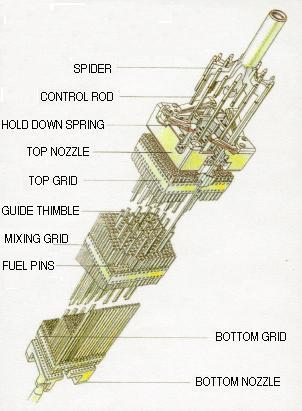Nuclear fuel
Uranium (U) is abundant in some parts of the world. Natural uranium is composed mainly of U-238 (about 99.28%) and a small portion of U-235 (about 0.71%) and a minute portion of U-234. U-235 is a fissile nuclide, i.e. a nuclide with a high probability of inducing fission after absorbing a low energy neutron (thermal neutron), whereas U-238 is not fissile. U-238 can induce fission after absorbing a high energy neutron (fast neutron) and then forming the Plutonium 239 (Pu-239), which is a fissile nuclide. Pu-239 would produce fission in the reactor in the same way as U-235 and contributes in supplying part of the energy for power generation.
In general, low enriched uranium fuel is used in commercial type PWR with light water as the coolant and moderator. The nuclear fuel in the reactor is originated from natural uranium but the percentage of U-235 in the fuel must be increased to 3 to 5% above that of natural uranium (i.e. 3 to 5 % enrichment) for use in the PWR in order to achieve a sustainable nuclear fission. The enriched uranium fuel in the form of uranium dioxide for the PWR is fabricated into a few hundreds of small fuel pellets, which are stacked up, enclosed and sealed in a zirconium alloy tube of about 3.8 metres in length and 9.5 mm in diameter (the fuel rod). The fuel rods then assembled in clusters to form the fuel assemblies for loading into the reactor core. The new fuel assembly has very low radioactivity and can be handled and transported safely. There are altogether 157 fuel assemblies with 264 fuel rods per assembly in the reactor core at GNPS and LNPS.

Fuel Assembly
Key parameters
- UO2 fuel pellets enclosed in fuel rod
- Zirconium alloy (zircaloy) fuel cladding
- Total 157 fuel assemblies
- 264 fuel rods per assembly
- 72.5 ton of uranium fuel in reactor core
- Use uranium fuel of 3 - 5 % enrichment